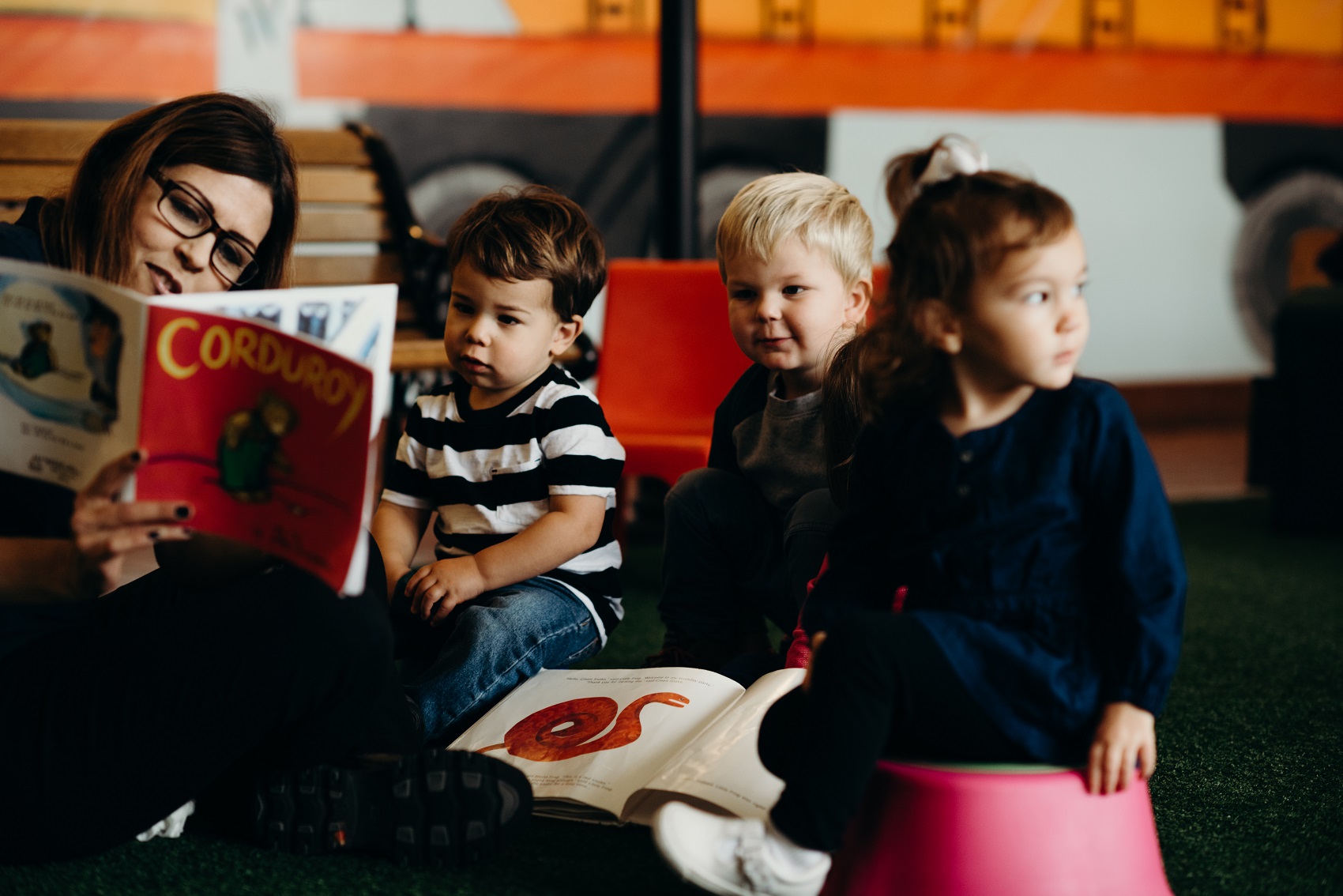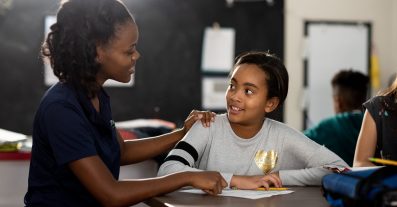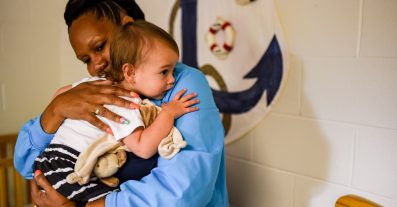INSPIRED in Health and Safety
Read ArticleApril 12, 2021
Promoting Young Children’s Social and Emotional Health
Originally posted on the NAEYC resources webpage
by JEANNIE HO SUZANNE FUNK
In a preschool classroom, some of the 3- and 4-year-old children smile, laugh, and giggle during free play; are curious about what happens next during story time; ask what and why questions while doing hands-on activities; and use words to express feelings and needs. In the toy area, Tom and Juan both reach for a small blue car. Tom says, “May I please have it first, then you have it later?” Juan replies, “You have it for five minutes and then I have it for five minutes.” Noticing this exchange, their teacher says, “Tom and Juan, you are talking about taking turns. What a great way to play together!”
Tom, Juan, and their classmates are a model of social and emotional health in preschool. Children who are socially and emotionally healthy tend to demonstrate, and continue to develop, several important behaviors and skills (adapted from McClellan & Katz 2001 and Bilmes 2012). They
- Are usually in a positive mood
- Listen and follow directions
- Have close relationships with caregivers and peers
- Care about friends and show interest in others
- Recognize, label, and manage their own emotions
- Understand others’ emotions and show empathy
- Express wishes and preferences clearly
- Gain access to ongoing play and group activities
- Are able to play, negotiate, and compromise with others
Why social and emotional health matters
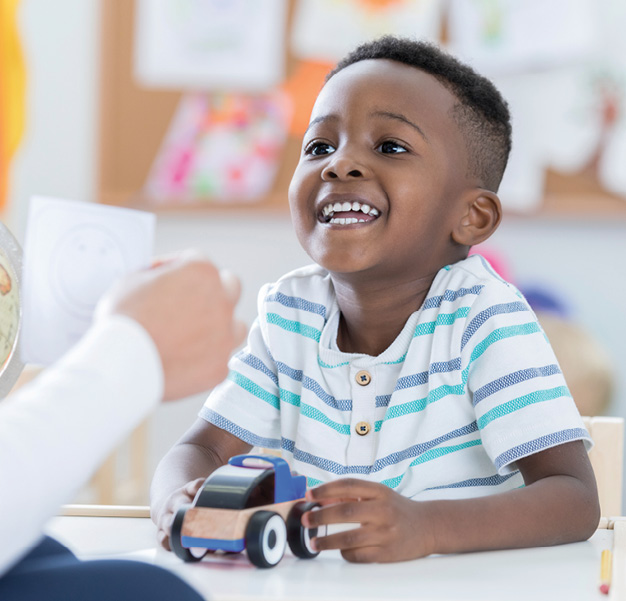 Children’s social and emotional health affects their overall development and learning. Research indicates that children who are mentally healthy tend to be happier, show greater motivation to learn, have a more positive attitude toward school, more eagerly participate in class activities, and demonstrate higher academic performance than less mentally healthy peers (Hyson 2004; Kostelnik et al. 2015). Children who exhibit social and emotional difficulties tend to have trouble following directions and participating in learning activities. Compared with healthier peers, they may be more likely to suffer rejection by classmates, have low self-esteem, do poorly in school, and be suspended (Hyson 2004; Kostelnik et al. 2015). Thus, children’s social and emotional health is just as important as their physical health, and affects their capacity to develop and potential to lead a fulfilling life.
Children’s social and emotional health affects their overall development and learning. Research indicates that children who are mentally healthy tend to be happier, show greater motivation to learn, have a more positive attitude toward school, more eagerly participate in class activities, and demonstrate higher academic performance than less mentally healthy peers (Hyson 2004; Kostelnik et al. 2015). Children who exhibit social and emotional difficulties tend to have trouble following directions and participating in learning activities. Compared with healthier peers, they may be more likely to suffer rejection by classmates, have low self-esteem, do poorly in school, and be suspended (Hyson 2004; Kostelnik et al. 2015). Thus, children’s social and emotional health is just as important as their physical health, and affects their capacity to develop and potential to lead a fulfilling life.
Teachers can promote children’s social and emotional health in many ways, for example, by organizing a material-rich environment to stimulate social interactions among children. This article focuses on two of the most important practices: building trusting relationships and conducting intentional teaching.
Establish trusting relationships
Young children develop and learn in the context of relationships. A trusting and caring teacher–child relationship is essential for children’s optimum development (Raikes & Edwards 2009). Children who have trusting relationships with their teachers are, on average, more willing to ask questions, solve problems, try new tasks, and express their thinking than their peers without such relationships (O’Connor & McCartney 2007). In her work supervising student teachers, Ho (the first author) often sees children developing positive social and emotional health as a result of close relationships with their teachers. For example, children learn to use words to express their feelings—such as Amy saying to Emily, “I am sad when you use hurting words!”—and to show empathy—as when Arjun gently pats Brian’s head and says, “Are you okay? Do you want to hold the teddy bear?”
Children benefit socially, emotionally, and academically when teachers intentionally create close, trusting relationships (Palermo et al. 2007). But gaining the trust of every child is not as simple as being nice and engaging. How can teachers create trusting relationships with all of the children? Consistently offering warmth, affection, respect, and caring is essential.
Showing warmth and affection consistently
Warmth and affection—even on bad days and when children are misbehaving—are critical to children’s well-being in early education settings (Ostrosky & Jung 2005). They contribute to developing secure relationships between children and adults, provide models of gentle behavior, and are linked with children’s ability to interact positively with peers (Twardosz 2005). The preschoolers we observed used gentle hands and kind words and positively interacted with peers most of the time. Their social and emotional well-being was nourished by their teachers’ warmth and affection, which is shown in the following examples:
- Ms. Johnson displays a pleasant facial expression throughout the day. She smiles when greeting children in the morning, says goodbye in the afternoon, and acknowledges children’s appropriate behaviors.
- Mr. Logan uses the appropriate tone of voice at all times. His speech is at normal pitch and volume; his tone is relaxed and soft. Even when he has to redirect a child’s behavior, he remains calm and warm to convey that his concern is with the behavior—not the child.
- Ms. Aragon gives appropriate touches when necessary, such as a pat on the back, a handshake, hugs, and brief tickles.
- Ms. Lizama moves physically close to the children and bends or crouches to be at the children’s eye level while talking to them.
- Mr. Sharma often uses loving comments to show he cares: “I am so happy to see you this morning!,” “I missed you yesterday,” “I love seeing your smile!” And he is careful to make such comments to all of the children in his classroom.
Respecting and caring about every child
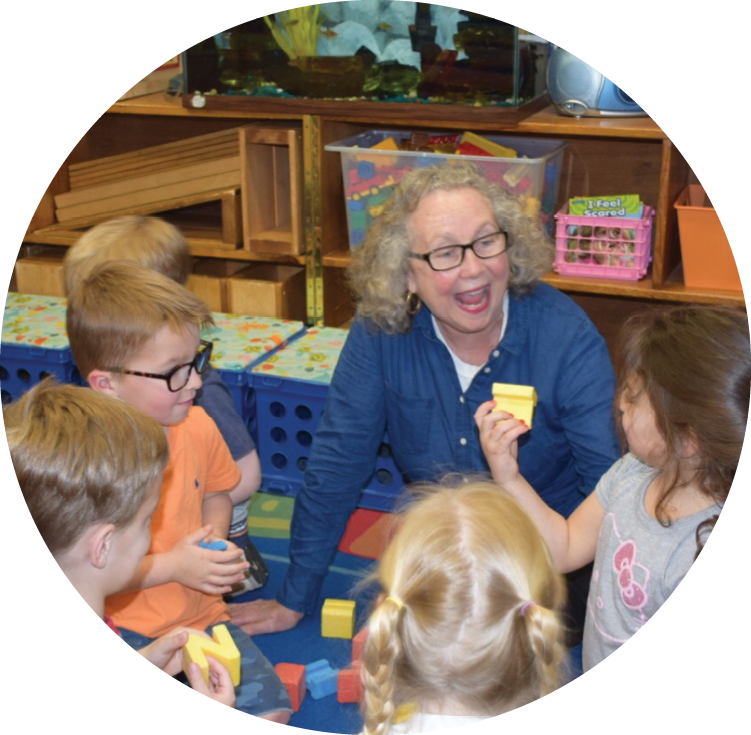
Showing respect is a key way to connect with children and strengthen positive relationships. It helps children feel more confident and competent to explore and learn (Dombro, Jablon, & Stetson 2011). Ms. Carnes establishes and maintains close personal bonds with every child in her classroom by consistently acting in respectful and caring ways. Specifically, she
- Listens with full attention and restates what children say (often also seizing the opportunity to expose the children to new vocabulary). Jason, a 4-year-old, says, “Look, I made a truck with lots of Legos!” Ms. Carnes replies, “Oh, I see, Jason. You built a truck with dozens of Legos.” Jason adds, “I use this truck to deliver apples and bananas to the grocery store.” Ms. Carnes responds, “Using a truck to deliver nutritious fruits to the grocery store is helpful.” Listening to children attentively and reflectively enhances their self-worth and confidence. When teachers actively listen to children, they convey that they care about what the children have to say, and the children are more likely to share their thoughts, ideas, feelings, and stories.
- Accepts and reflects children’s feelings. Frowning, Jasper says to the teacher, “Michael has all the big blocks!” Ms. Carnes responds, “Jasper, you seem upset that there are no more large blocks to build with right now. It is difficult to wait!” Amy says with enthusiasm, “We are about to go outside!” Ms. Carnes answers, “The sparkles in your eyes tell me you can hardly wait to go outside. You are excited.” When they accept and reflect children’s feelings, teachers exhibit sensitivity and caring in a way children understand. Teachers’ acknowledgments make children feel heard and accepted (Duffy 2008). As a result, children feel safe to express their emotions—and receive support in identifying, labeling, and better understanding their emotions.
- Spends private, quality time with individual children through one-on-one activities, such as story reading and game playing. Emily is sad when her mom leaves. Ms. Carnes reads her a book in a cozy corner with soft pillows and stuffed animals. Afterward, Emily is ready to explore and play in the classroom. Judy complains that no one wants to play with her at the tactile table. Ms. Carnes sits at the table and plays with Judy until another child joins the play. In addition, Ms. Carnes spends quality time with individual children by putting aside other work, moving to the child’s level, and conversing openly with the child. Ms. Carnes keeps track to ensure that she speaks with each child regularly, which deepens their relationship and builds trust (Gartrell 2007). Ms. Carnes finds time for these conversations throughout the day, especially during greeting, free play, snack, lunch, and departure time.
Teach social and emotional skills intentionally
Helping children develop social and emotional skills is the heart and soul of any good program for young children (Gordon & Browne 2014). Teachers (and all caregivers) play key roles in helping children develop social and emotional competence (Kostelnik et al. 2015). Teachers can intentionally support children’s social and emotional health by using children’s books, planning activities, coaching on the spot, giving effective praise, modeling appropriate behaviors, and providing cues.
Warmth and affection—even on bad days and when children are misbehaving—are critical to children’s well-being in early education.
Using children’s books
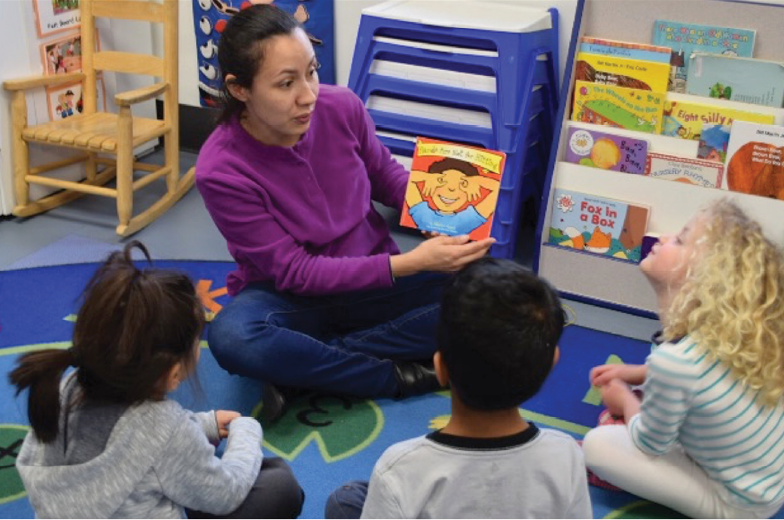
Reading and discussing children’s books is an excellent way to invite children to identify the characters’ emotions and relate the characters’ experiences to their own (Roberts & Crawford 2008). To introduce a new social or emotional skill, Ms. Coz carefully chooses high-quality books to read aloud at circle time. Sometimes she chooses books related to children’s recent social and emotional behaviors in the classroom. When she sees some of the children having trouble sharing toys, she reads aloud The Rainbow Fish, by Marcus Pfister. When she finds a child crying because her friend hit her, Ms. Coz reads aloud Hands Are Not for Hitting, by Elizabeth Verdick. (See “Children’s Books for Teaching Social and Emotional Skills,” for more titles to consider.)
To connect the characters and situations in the book with the children’s experiences, Ms. Coz plans to read the book at least twice and also add it to the classroom library. During the second reading, she asks meaningful questions: “What do you think the characters are feeling?,” “How would you solve the problem?,” “Can you use words from the story to explain how you feel when you . . .?,” “What could we do differently if this happens in our classroom?” These open-ended questions enable children to talk about their own experiences, learn new vocabulary words, and practice social and emotional skills.
Planning activities
To extend and apply what children learn from reading stories, Ms. Coz plans follow-up activities, such as hands-on crafts, games, and songs. She often uses Book Nook guides, created by the Center on the Social and Emotional Foundations for Early Learning (http://csefel.vanderbilt.edu/resources/strategies.html#booknook). These guides help her embed social and emotional development activities into daily routines, including read-alouds. (See “Activities for Supporting Children’s Social and Emotional Learning” for some ideas adapted from Book Nook guides.)
Coaching on the spot
When they coach children on the spot, teachers help children realize what they are doing, understand how their actions affect others, and choose positive alternatives (Riley et al. 2008). For example, when Ryan and Ethan build a firehouse in the block area, Ethan grabs the fire truck from Ryan, and Ryan cries. Ms. Coz crouches down at Ethan’s level to look into his eyes; calmly and warmly, she says, “Ryan was still using the truck. When you took it away from him, he got upset. What could you do to make Ryan feel better?” After Ethan says he is sorry and gives back the fire truck, Ms. Coz says, “Next time if you want to play with the toy Ryan is using, could you ask if he will share?” Ms. Coz follows up by observing Ethan and providing immediate positive feedback on his desirable behavior.
Giving effective praise
Meaningful feedback pertinent to the task at hand in the form of effective praise is a powerful strategy for fostering children’s social and emotional development (Kostelnik et al. 2015). To make praise effective, teachers describe specifically what they see—without generalizing, evaluating, or making comparisons. When Emily finishes her drawing, Ms. Coz notices her picture and her smile. Ms. Coz says, “I see a blue sky, a yellow sun, and green grass around the big brown tree. This picture makes you happy, doesn’t it?” This praise is effective because Ms. Coz offers detailed, positive comments immediately after desirable behavior occurs. Noticing Ethan asking Ryan politely for a policewoman figure, Ms. Coz says, “Ethan, you used the magic words May I please? to ask for that policewoman while you and Ryan were building the firehouse together. Great job!” Smiling, Ethan responds, “We are friends and we can share things.”
Modeling appropriate behavior
Children learn by observing other people, getting ideas about how new behaviors are formed, and using the ideas to guide their actions (Bandura 1977). Many studies have found that modeling—or demonstrating appropriate behaviors—teaches and enhances children’s social and emotional skills (Katz & McClellan 1997; Hyson 2004). This research-based conclusion is evidenced in Ms. Coz’s and Ms. Carnes’s classes. Both teachers implement several noninvasive strategies—including modeling—that their center administrators created to support teachers in promoting socially and emotionally healthy behaviors. They display the strategies on the classroom wall and put them into action by
- Moving closer to children, when needed, as a nonverbal cue to rethink behaviors
- Modeling appropriate warm and respectful behavior throughout the day and at specific moments when a gentle reminder is needed
- Using nonverbal gestures and contact (e.g., nodding the head, giving thumbs-up signs, and touching children gently on the shoulder) to send messages
- Employing simple language (e.g., “Walking feet, please” and “Use gentle hands”) to set expectations and give reminders
- Acknowledging a kind act on the spot or praising a group effort for a job well done
- Placing a hand—gently—on a child’s hand to redirect attention and behavior
When children see teachers demonstrate these noninvasive strategies, they often smile, use their gentle hands, say please and thank you, give hugs and high fives, and use words to express their feelings.
In addition to being role models, the teachers use the children’s appropriate behaviors to model social and emotional skills. They carefully observe and record details about how children apply the target skills, and they share their observations with the children through puppet shows during circle time. Using puppets to demonstrate children’s appropriate behaviors helps children learn social and emotional skills meaningfully.
Providing cues
Providing cues to engage children in appropriate social behavior has been shown over time to improve their social behavior with their peers (Bovey & Strain 2005). Ms. Coz and Ms. Carnes often provide verbal cues to help some children participate in activities. Before playtime, for example, Ms. Carnes asks, “James, who are you going to ask to play with you at center time?” During playtime, she suggests, “Saanvi, can you ask Anna to build an airplane with you?” To teach sharing and turn taking, Ms. Coz asks Steven, who has been waiting to play with a toy dolphin for a while, “What magic words could you use to have a turn with the dolphin John is using?”
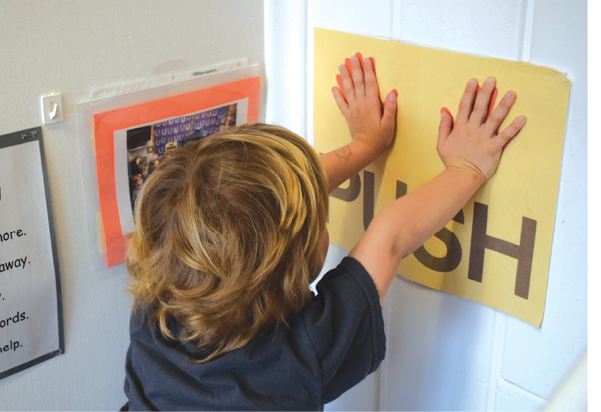
Both Ms. Coz and Ms. Carnes prominently display visual cues in their classrooms to assist children’s social and emotional interactions. For example, they provide teacher-made hand puppets to guide children to use quiet voices, helping hands, and walking feet. To help children calm down, they also created a “push wall”—a designated spot on the wall to push anger out—and use puppets to demonstrate the strategy. These puppets, demonstrations, and explanations are essential for clarifying and modeling appropriate behavior—and the visual cues are essential for reminding the children to practice what they have learned. Long-term visual cues function like a third teacher in the sense that children use the cues to remind one another of solutions and appropriate actions.
Conclusion
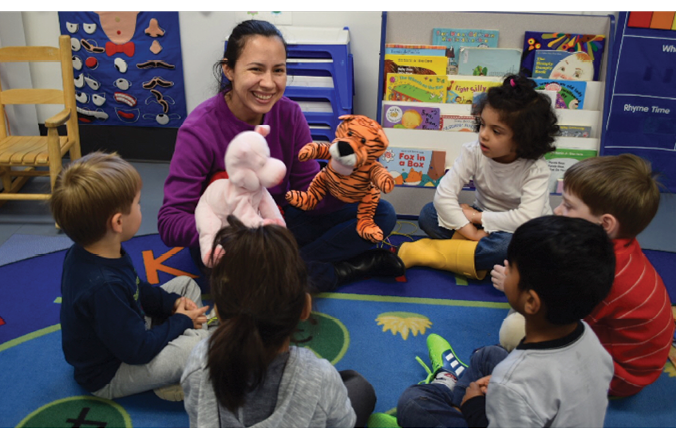 Teachers and caregivers promote children’s social and emotional health by establishing trusting relationships, created when teachers express warmth, affection, and respect. Teachers can intentionally teach and enhance these skills using evidence-based strategies to teach, model, and reinforce positive behaviors. As evidenced in the preschool classrooms we observed, teachers who prioritize developing children’s social and emotional health are richly rewarded with happy, engaged children who learn to avoid and resolve conflicts, share and take turns, and express their emotions in productive ways.
Teachers and caregivers promote children’s social and emotional health by establishing trusting relationships, created when teachers express warmth, affection, and respect. Teachers can intentionally teach and enhance these skills using evidence-based strategies to teach, model, and reinforce positive behaviors. As evidenced in the preschool classrooms we observed, teachers who prioritize developing children’s social and emotional health are richly rewarded with happy, engaged children who learn to avoid and resolve conflicts, share and take turns, and express their emotions in productive ways.
Children’s Books for Teaching Social and Emotional Skills
- Can You Be a Friend?, by Nita Everly
- Care Bears Caring Contest, by Nancy Parent, illus. by David Stein
- Fox Makes Friends, by Adam Relf
- How Do Dinosaurs Play with Their Friends?, by Jane Yolen and Mark Teague
- How I Feel Frustrated, by Marcia Leonard
- I Can Do It Myself (a Sesame Street Series), by Emily Perl Kingsley, illus. by Richard Brown
- I’m in Charge of Me!, by David Parker, illus. by Sylvia Walker
- Mouse Was Mad, by Linda Urban, illus. by Henry Cole
- My Many Colored Days, by Dr. Seuss, illus. by Steve Johnson and Lou Fancher
- Sharing: How Kindness Grows, by Fran Shaw, illus. by Miki Sakamoto
- When I’m Feeling Sad, by Trace Moroney
- When Sophie Gets Angry—Really, Really Angry, by Molly Bang
Activities for Supporting Children’s Social and Emotional Learning
Helping hands chain: Trace and cut out multiple hands for each child. Place them in a pocket or baggie that is easily accessible. As you recognize a child’s helping hand behavior, have the child get a hand from their pocket and connect it to the class’s helping hand chain. The hands can be placed on the wall to wrap around the room. On a regular basis, celebrate how long the helping hand chain is getting!
Hand puppets: Create character puppets by having children color or paint the pictures, cut them out, and glue them to craft sticks. Once dry, children can bring their puppets to circle time and act out the story while you read the story aloud. Later, they can take the puppets to the story area or puppet center.
Moving to music: Choose songs with lyrics that encourage movement. Before you start, remind the children that they need to listen closely to the words so they know what actions to take. Classic songs like “Head, Shoulders, Knees, and Toes” work well. Many children’s CDs have great songs that involve following directions (try “My Ups and Downs,” and “Hands Are for Clapping,” by Jim Gill). Do the motions with the children as you listen to the songs. After listening to each song several times, children will build confidence and know which motions to do on their own. Point out to the children that they know what to do because they are being such good listeners.
Pass the feeling bag: Place an assortment of scenario picture cards in a bag. As music plays, the children pass the bag. When the music stops, one child picks out a card and identifies it. Have the child talk about how each scenario or item makes him feel and why. Allow children to take turns pulling out picture cards.
Feeling faces collage: Have children cut out different feeling faces from magazines. Mix nontoxic glue and water together in a small bowl. The children put the pictures on top of a piece of paper, take a paintbrush and dip it in glue solution, and paint over their pictures. They can hang their feeling faces collages on the wall.
Share box: Create a special share box that is only introduced during circle time. Children can decorate the box with primary colors or with a bold pattern. Inside the box, place items that can be shared, such as musical instruments, a box of chunky sidewalk chalk, playdough, or several sensory bottles.
Singing: After a story about sharing with friends, sing “Share, share, share your toys; share them with a friend. Share, share, share your toys, let’s all play pretend,” to the tune of “Row, Row, Row Your Boat.” After a story about feelings, sing “If You’re Happy and You Know It” with a variety of emotions and body gestures.
Note: Adapted with permission from Book Nook, created by the Center on the Social and Emotional Foundations for Early Learning. To use Book Nook guides at no cost, visit http://csefel.vanderbilt.edu/resources/strategies.html#booknook.
References
Bandura, A. 1977. Social Learning Theory. Englewood Cliffs, NJ: Prentice-Hall.
Bilmes, J. 2012. Beyond Behavior Management: The Six Life Skills Children Need, 2nd ed. St. Paul, MN: Redleaf.
Bovey, T., & P. Strain. 2005. “Strategies for Increasing Peer Social Interactions: Prompting and Acknowledgment.” Center on the Social and Emotional Foundations for Early Learning. What Works Briefs. http://csefel.vanderbilt.edu/briefs/wwb17.pdf.
Dombro, A.L., J. Jablon, & C. Stetson. 2011. Powerful Interactions: How to Connect with Children to Extend Their Learning. Washington, DC: National Association for the Education of Young Children (NAEYC).
Duffy, R. 2008. “Are Feelings Fixable?” Exchange 30 (6): 87–90.
Gartrell, D. 2007. A Guidance Approach for the Encouraging Classroom, 4th ed. Florence, KY: Thomson Delmar Learning.
Gordon, A.M., & K.W. Browne. 2014. Beginnings and Beyond: Foundations in Early Childhood Education, 9th ed. Belmont, CA: Cengage.
Hyson, M. 2004. The Emotional Development of Young Children: Building an Emotion-Centered Curriculum, 2nd ed. New York: Teachers College Press.
Katz, L.G., & D.E. McClellan. 1997. Fostering Children’s Social Competence: The Teacher’s Role. Washington, DC: NAEYC.
Kostelnik, M.J., A.K. Soderman, A.P. Whiren, M.L. Rupiper, & K.M. Gregory. 2015. Guiding Children’s Social Development and Learning: Theory and Skills, 8th ed. Stamford, CT: Cengage.
McClellan, D., & L.G. Katz. 2001. “Assessing Young Children’s Social Competence.” Champaign, IL: ERIC Clearinghouse on Elementary and Early Childhood Education. http://files.eric.ed.gov/fulltext/ED450953.pdf.
O’Connor, E., & K. McCartney. 2007. “Examining Teacher–Child Relationships and Achievement as Part of an Ecological Model of Development.” American Educational Research Journal 44 (2): 340–69.
Ostrosky, M.M., & E.Y. Jung. 2005. “Building Positive Teacher–Child Relationships.” Center on the Social and Emotional Foundations for Early Learning. What Works Briefs. http://csefel.vanderbilt.edu/briefs/wwb12.pdf.
Palermo, F., L.D. Hanish, C.L. Martin, R.A. Fabes, & M. Reiser. 2007. “Preschoolers’ Academic Readiness: What Role Does the Teacher–Child Relationship Play?” Early Childhood Research Quarterly 22 (4): 407–22. www.ncbi.nlm.nih.gov/pmc/articles/PMC3856866.
Raikes, H.H., & C.P. Edwards. 2009. Extending the Dance in Infant and Toddler Caregiving: Enhancing Attachment and Relationships. Baltimore, MD: Brookes.
Riley, D., R.R. San Juan, J. Klinkner, & A. Ramminger. 2008. Social and Emotional Development: Connecting Science and Practice in Early Childhood Settings. St. Paul, MN: Redleaf; Washington, DC: NAEYC.
Roberts, S.K., & P.A. Crawford. 2008. “Real Life Calls for Real Books: Literature to Help Children Cope with Family Stressors.” Young Children 63 (5): 12–17.
Twardosz, S. 2005. “Expressing Warmth and Affection to Children.” Center on the Social and Emotional Foundations for Early Learning. What Works Briefs. http://csefel.vanderbilt.edu/briefs/wwb20.pdf.
Photographs: © Getty Images; courtesy of Geneva Day School

